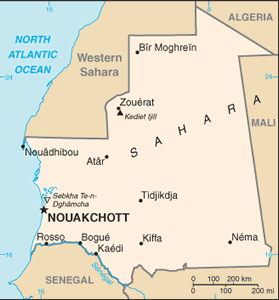The Geography of Mauritania
The Geography of Mauritania
Mauritanian Geography
Location: Northern Africa, bordering the North Atlantic Ocean, between Senegal and Western Sahara
Geographic coordinates: 20 00 N, 12 00 W
Map references: Africa
Area: total: 1,030,700 sq km land: 1,030,400 sq km water: 300 sq km
Area - comparative: slightly larger than three times the size of New Mexico
Land boundaries: total: 5,074 km border countries: Algeria 463 km, Mali 2,237 km, Senegal 813 km, Western Sahara 1,561 km
Coastline: 754 km
Maritime claims: territorial sea: 12 nm contiguous zone: 24 nm exclusive economic zone: 200 nm continental shelf: 200 nm or to the edge of the continental margin
Climate: desert; constantly hot, dry, dusty
Terrain: mostly barren, flat plains of the Sahara; some central hills
Elevation extremes: lowest point: Sebkhet Te-n-Dghamcha -5 m highest point: Kediet Ijill 915 m
Natural resources: iron ore, gypsum, copper, phosphate, diamonds, gold, oil, fish
Land use: arable land: 0.2% permanent crops: 0.01% other: 99.79% (2005)
Irrigated land: 490 sq km (2002)
Natural hazards: hot, dry, dust/sand-laden sirocco wind blows primarily in March and April; periodic droughts
Environment - current issues: overgrazing, deforestation, and soil erosion aggravated by drought are contributing to desertification; limited natural fresh water resources away from the Senegal, which is the only perennial river; locust infestation
Environment - international agreements: party to: Biodiversity, Climate Change, Climate Change-Kyoto Protocol, Desertification, Endangered Species, Hazardous Wastes, Law of the Sea, Ozone Layer Protection, Ship Pollution, Wetlands, Whaling signed, but not ratified: none of the selected agreements
Geography - note: most of the population concentrated in the cities of Nouakchott and Nouadhibou and along the Senegal River in the southern part of the country


